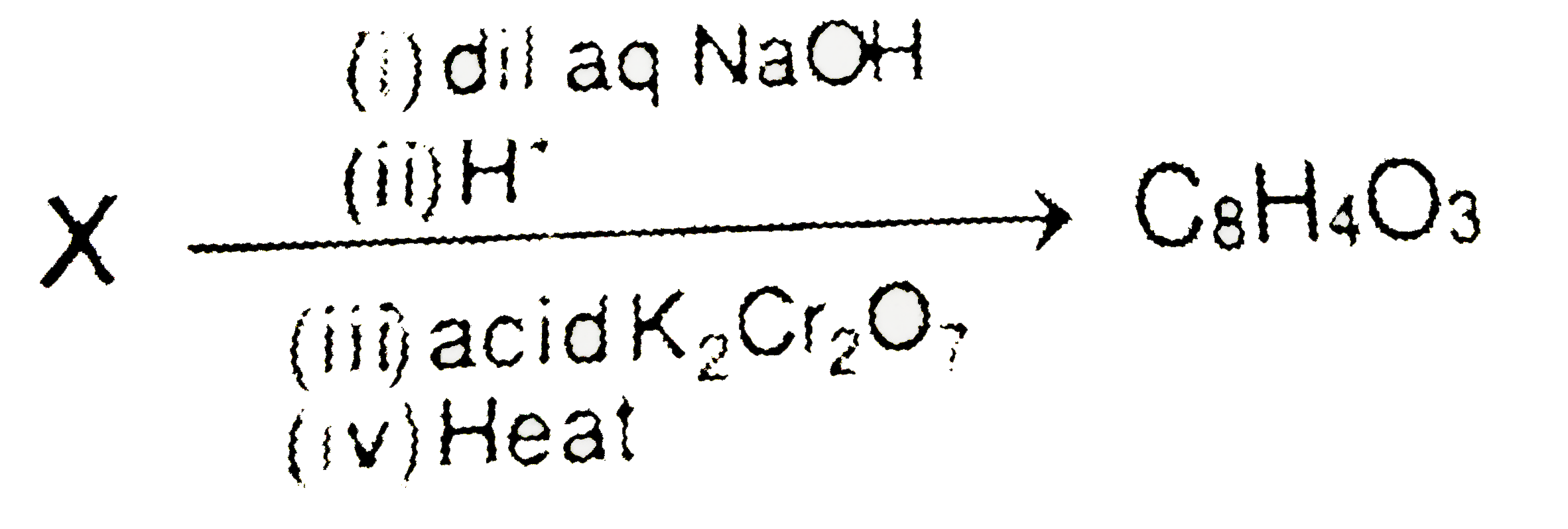The compound X in the reaction X + Zn 3 -Hexene, is
3, 4-Dichlorohexane
1, 1-Dichloropropane
Both (1) and (2)
None of the above
The correct Answer is:C
To determine the compound X in the reaction X+Zn→3-Hexene, we can analyze the structure of 3-Hexene and the possible reactants that could yield this product when reacted with zinc.
Step 1: Identify the structure of 3-Hexene
3-Hexene is an alkene with the following structure:
- It has a total of 6 carbon atoms (hex).
- The double bond is located between the 3rd and 4th carbon atoms.
The structure can be represented as:
CH3−CH2−C=C−CH2−CH3
Step 2: Analyze the possible reactants
To form 3-Hexene through a reaction with zinc, we need to consider compounds that can undergo dehydrohalogenation (removal of hydrogen halide) in the presence of zinc.
Step 3: Consider the reactants
1. 3,4-Dichlorohexane:
- Structure:
CH3−CH2−C(Cl)−C(Cl)−CH2−CH3
- When reacted with zinc, the zinc will remove the two chlorine atoms, leading to the formation of a double bond between the 3rd and 4th carbon atoms, resulting in 3-Hexene.
2. 1,1-Dichloropropane:
- Structure:
CH3−CH2−C(Cl)−C(Cl)−CH2−CH3
- This compound can also react with zinc to form 3-Hexene by removing the chlorine atoms and forming a double bond.
Step 4: Conclusion
Both 3,4-Dichlorohexane and 1,1-Dichloropropane can react with zinc to form 3-Hexene. Therefore, the compound X in the reaction can be either of these two compounds.
Final Answer:
The compound X in the reaction X+Zn→3-Hexene is 3,4-Dichlorohexane or 1,1-Dichloropropane.
---
3-Hexene is an alkene with the following structure:
- It has a total of 6 carbon atoms (hex).
- The double bond is located between the 3rd and 4th carbon atoms.
CH3−CH2−C=C−CH2−CH3
To form 3-Hexene through a reaction with zinc, we need to consider compounds that can undergo dehydrohalogenation (removal of hydrogen halide) in the presence of zinc.
1. 3,4-Dichlorohexane:
- Structure:
CH3−CH2−C(Cl)−C(Cl)−CH2−CH3
- When reacted with zinc, the zinc will remove the two chlorine atoms, leading to the formation of a double bond between the 3rd and 4th carbon atoms, resulting in 3-Hexene.
- Structure:
CH3−CH2−C(Cl)−C(Cl)−CH2−CH3
- This compound can also react with zinc to form 3-Hexene by removing the chlorine atoms and forming a double bond.
Both 3,4-Dichlorohexane and 1,1-Dichloropropane can react with zinc to form 3-Hexene. Therefore, the compound X in the reaction can be either of these two compounds.
The compound X in the reaction X+Zn→3-Hexene is 3,4-Dichlorohexane or 1,1-Dichloropropane.
Topper's Solved these Questions
- HALOALKANES & HALOARENES BOOK - VMC MODULES ENGLISHCHAPTER - HALOALKANES & HALOARENES EXERCISE - ENABLE
99 Videos
- HALOALKANES & HALOARENES BOOK - VMC MODULES ENGLISHCHAPTER - HALOALKANES & HALOARENES EXERCISE - EFFICIENT
100 Videos
- ENVIRONMENTAL CHEMISTRYBOOK - VMC MODULES ENGLISHCHAPTER - ENVIRONMENTAL CHEMISTRYEXERCISE - JEE Main (Archive)
39 Videos
- HALOALKANES AND HALOARENESBOOK - VMC MODULES ENGLISHCHAPTER - HALOALKANES AND HALOARENESEXERCISE - IN-CHAPTER EXERCISE - F
6 Videos
Similar Questions
Knowledge Check
 , Compound (x) in the above reaction is :APh−O∣∣C−CH3BPh−O∣∣C−HCPh−CH2−O∣∣C−HDPh−CH2−O∣∣C−CH3
, Compound (x) in the above reaction is :APh−O∣∣C−CH3BPh−O∣∣C−HCPh−CH2−O∣∣C−HDPh−CH2−O∣∣C−CH3
Compound "X" in the following reaction is

View SolutionCompound "X" in the following reaction is

View SolutionThe compound 'X' undergoing the following reaction is

View SolutionComplete the given redox reaction
Zn+AgCN→
View SolutionZn+2NaOH→A+B
View SolutionReduction potential for the following half-cell reaction are
Zn→Zn2++2e−,E∘Zn2+/Zn=−0.76V
Fe→Fe2++2e−,E∘Fe2+/Fe=−0.44V
The emf for the cell reaction
Fe2++Zn→Zn2++Fe
will be
View SolutionAg++e−→Ag,E0=+0.8VandZn2++2e−→Zn,E0=−076V. Calculate the cell potential for the reaction, 2Ag+Zn2+→Zn+2Ag+
View Solution


